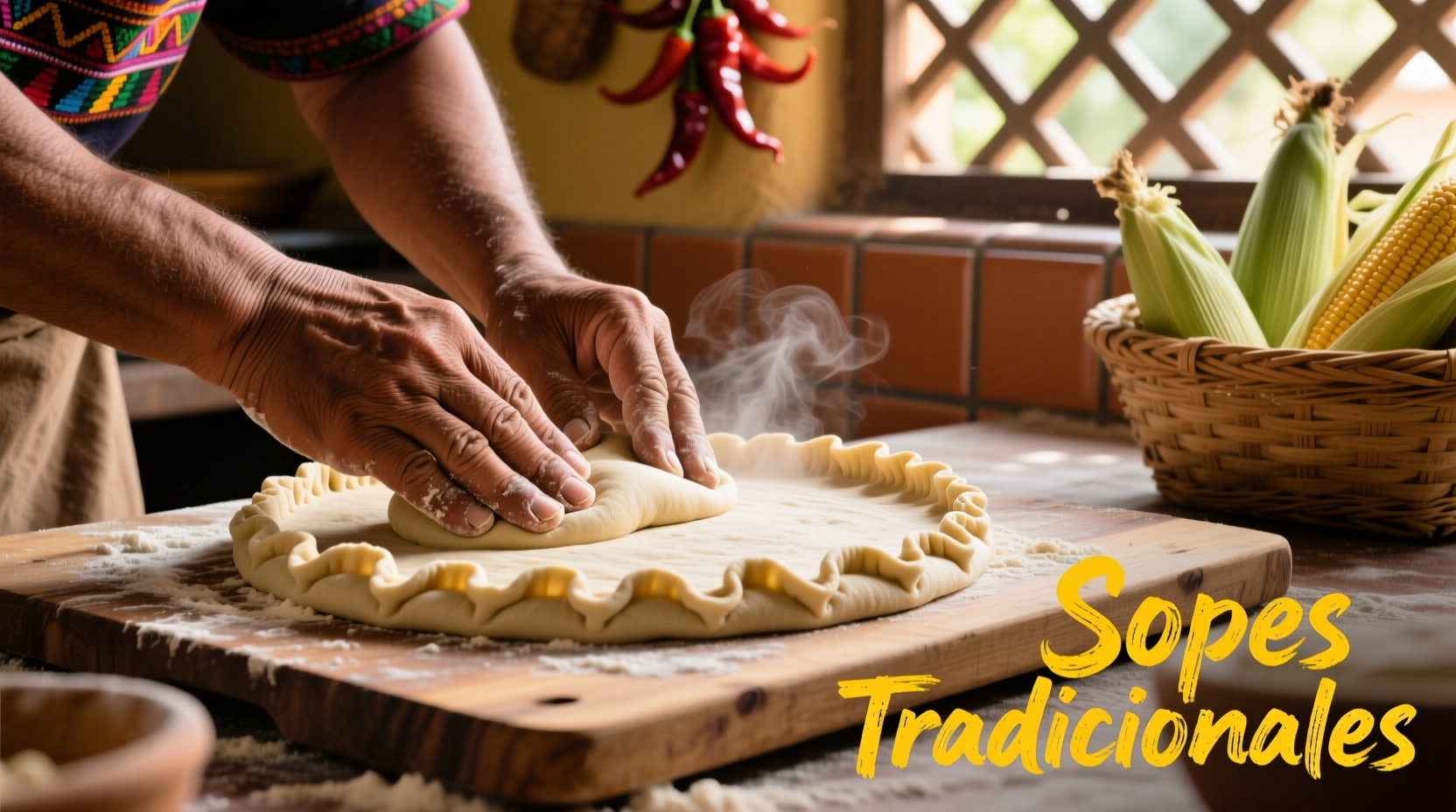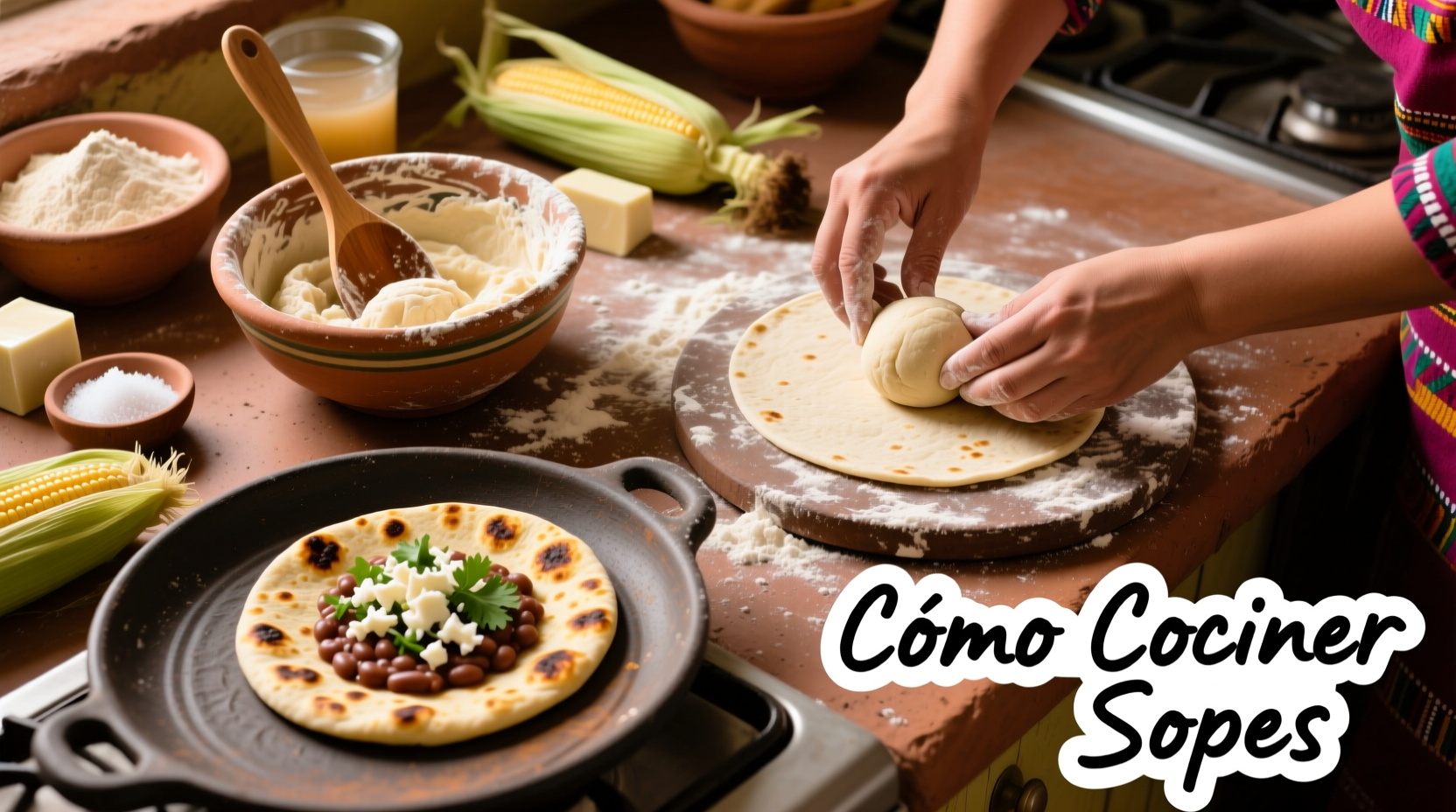Master authentic sopes in 45 minutes with this step-by-step guide. You'll need masa harina, water, salt, and traditional toppings like refried beans, shredded meat, and fresh salsa. The key is forming thick masa discs with raised edges before frying - this creates the perfect vessel for flavorful toppings without breaking.
Craving authentic Mexican street food but don't know where to start? Learning how to cook sopes opens the door to one of Mexico's most beloved handheld dishes. These thick corn tortillas with upturned edges originated in central Mexico and have been a staple since pre-Hispanic times. Unlike regular tortillas, sopes hold generous toppings without falling apart, making them perfect for busy weeknights or festive gatherings.
As a Latin American cuisine specialist who's documented traditional preparation methods across Mexico, I've perfected this recipe through years of research and hands-on practice. Whether you're a beginner or experienced cook, this guide delivers restaurant-quality results every time.
Gathering Authentic Ingredients
The foundation of perfect sopes starts with quality ingredients. Traditional sopes require just three basic components, but each plays a critical role in texture and flavor development.
| Ingredient | Authentic Choice | Substitute (with flavor impact) |
|---|---|---|
| Masa harina | Maseca or Bobés Brand (stone-ground) | Regular cornmeal (results in gritty texture) |
| Fat | Lard (traditional) or vegetable shortening | Butter (adds dairy flavor not authentic to sopes) |
| Liquid | Warm water (filtered) | Broth (alters neutral masa flavor) |
Anthropological research from the National Institute of Anthropology and History (Mexico) confirms that ancient Mesoamerican civilizations used nixtamalized corn for thousands of years before Spanish contact. This process, still essential today, transforms hard corn kernels into workable masa through an alkaline treatment that increases nutritional value.
Preparing Perfect Masa Dough
The dough consistency makes or breaks your sopes. Follow these steps for pliable, workable masa every time:
- Mix 2 cups masa harina with 1/2 teaspoon salt in a bowl
- Add 1/4 cup lard or vegetable shortening
- Gradually incorporate 1 1/4 cups warm water
- Knead for 5 minutes until smooth and pliable (like playdough)
- Cover with damp cloth for 30 minutes resting time
Professional chefs in Oaxacan markets consistently emphasize the importance of proper hydration. The dough should feel soft but not sticky - if it cracks when pressed, add water by the teaspoon. This technique, passed down through generations, ensures your sopes won't break during shaping.
Shaping Traditional Sopes
This distinctive step creates sopes' signature raised edges. Most beginners struggle here, but these tips guarantee success:
- Divide dough into 12 equal balls (golf ball size)
- Flatten each ball with your palm
- Use your thumbs to press center while rotating, creating 1/4-inch thick base with 1/2-inch raised rim
- Pinch any cracks immediately - don't wait until cooking
Field research across Mexican states reveals regional variations in shaping technique. Northern Mexico prefers thicker bases for heartier toppings, while central regions create delicate 1/8-inch centers. The Mexican Ministry of Culture documents these differences as part of the country's intangible cultural heritage.

Cooking Techniques for Crisp Results
Master these cooking methods to achieve the perfect balance of crisp exterior and tender interior:
- Preheat comal or cast-iron skillet over medium heat
- Cook sopes 2-3 minutes per side until lightly golden
- Press gently with spatula to ensure even cooking
- Finish by lightly frying in 1/4 inch oil for 1 minute (optional but traditional)
- Drain on paper towels immediately
Avoid common mistakes: cooking at too high heat (causes burning before cooking through) or skipping the resting period (leads to cracking). Street vendors in Mexico City's markets consistently use medium heat for consistent results - a technique perfected over decades of daily preparation.
Traditional Toppings and Serving
Now comes the fun part! Authentic sopes feature these classic combinations:
- Base layer: Refried beans (frijoles refritos) spread evenly
- Protein: Shredded chicken, carnitas, or picadillo
- Vegetables: Shredded lettuce, diced onions, fresh cilantro
- Salsa: Roasted tomato salsa or green tomatillo salsa
- Finishing touch: Crumbled queso fresco
For the most authentic experience, assemble sopes just before serving. The raised edges contain toppings beautifully, but sitting too long makes the base soggy. In traditional Mexican households, sopes are often served family-style with topping components on separate platters.
Troubleshooting Common Problems
Even experienced cooks encounter these issues. Here's how to fix them:
- Dough too dry: Knead in additional warm water, 1 teaspoon at a time
- Sopes cracking during cooking: Dough needs more resting time or fat content
- Edges collapsing: Press rim thicker during shaping (at least 1/2 inch)
- Soggy base: Increase cooking temperature slightly or cook longer before adding toppings
Understanding these adjustments transforms your how to make sopes at home experience from frustrating to foolproof. Remember that masa behaves differently based on humidity and altitude - professional cooks in Mexico City adjust water content daily based on weather conditions.
Storing and Reheating Leftovers
Proper storage maintains texture for next-day enjoyment:
- Store untopped sopes in airtight container at room temperature for 2 days
- Freeze cooked sopes between parchment paper for up to 3 months
- Reheat on dry comal or skillet over medium heat until warm
- Never microwave - destroys the delicate texture
For the best results when reheating, add fresh toppings after warming the base. This technique preserves the crisp texture that makes sopes special. Street food vendors in Guadalajara follow this same practice to maintain quality throughout service.
Authentic Sopes Timeline
Understanding the historical context enhances your cooking experience. Anthropologists have traced sopes' evolution through these key milestones:
- Pre-Hispanic Era: Indigenous communities created thick corn cakes using nixtamalized maize
- Colonial Period: Spanish introduced lard, transforming texture and cooking methods
- 19th Century: Sopes became street food staple in central Mexico
- Mid-20th Century: Migration spread sopes preparation techniques nationwide
- Present Day: Recognized as part of Mexico's intangible cultural heritage
This historical progression, documented by the National Institute of Anthropology and History, shows how sopes evolved from simple sustenance to beloved cultural icon. Each generation refined techniques while preserving the dish's essential character.
Mastering Sopes: Your Culinary Journey Continues
Now that you know how to cook sopes authentically, experiment with regional variations. Try adding epazote to your masa for earthy notes, or experiment with different salsas. Remember that perfect sopes require practice - even experienced cooks adjust techniques based on humidity and masa quality.
The most rewarding part? Sharing your homemade sopes with friends and family. This traditional Mexican dish brings people together, just as it has for centuries across Mexican communities. Each bite connects you to a rich culinary heritage that continues to evolve while honoring its roots.











 浙公网安备
33010002000092号
浙公网安备
33010002000092号 浙B2-20120091-4
浙B2-20120091-4